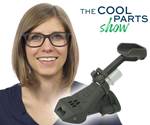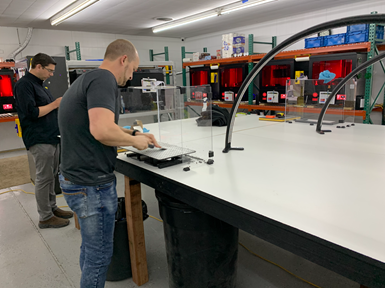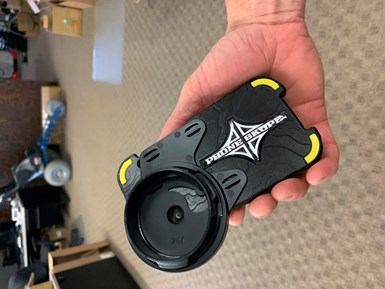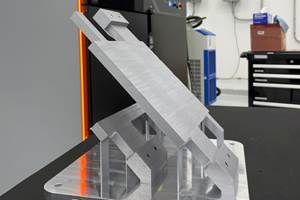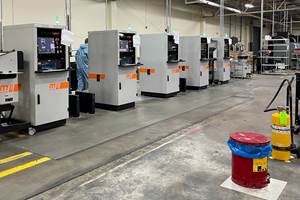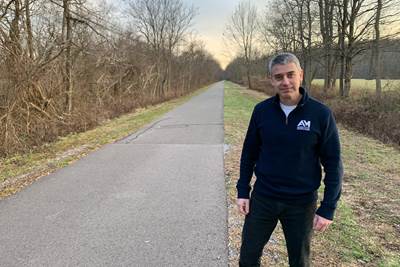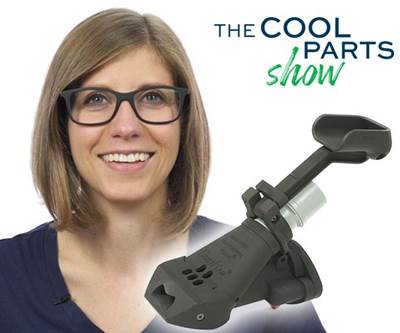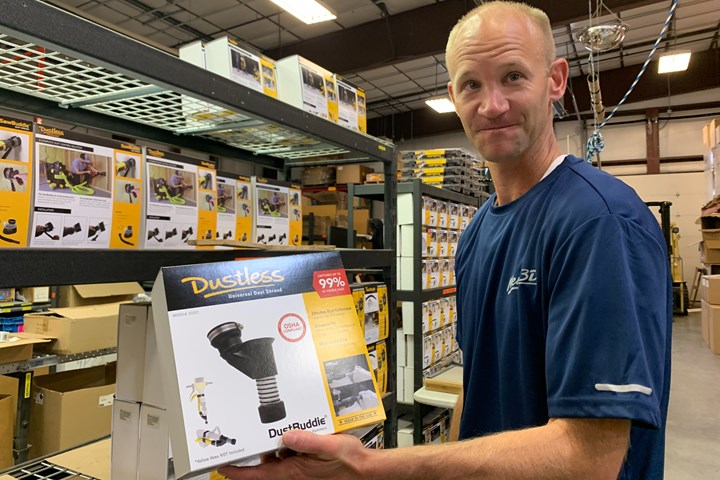
Dustless CEO Spencer Loveless is reinventing the way his company thinks about manufacturing. Production in the past has been offshored. The DustBuddie for demo hammers, the product he is holding, is manufactured in the U.S., and the company is investing in 3D printing technology to manufacture at its own facility. (Watch our episode of The Cool Parts Show on the DustBuddie for demo hammers for much more about the production of this product.)
The DustBuddie is the fitting seen here connecting the shop vac to a jack hammer. Making large components such as the vacuum’s housing through additive manufacturing is not yet cost-effective. But making this fitting through AM is cost-effective, and Dustless expects the scope of parts that make sense for additive will continue to grow.
Photo Credit: Dustless
Dustless Technologies, maker of wet-dry vacuums and related accessories — some for contractors and some hold in Home Depot — has been relying on sources in China for a considerable share of its manufacturing for over 20 years.
Spencer Loveless, CEO and second-generation owner of the company located in rural Price, Utah, has never been content with this. Finding a workable alternative to injection molding is the key to repatriating his company’s manufacturing, he says. He has been watching the advance of polymer 3D printing for years with this hope in mind, and the technology is now nearly close enough to being able to fill this role. It is so close that Dustless has gone ahead: Its newest product offering, an accessory for contractors, is being mass produced through additive manufacturing (AM) instead of molding. This product is being made by an AM supplier, but Dustless is also developing its own internal manufacturing capacity and expertise through contract work being done on the AM equipment it has installed in its own facility.
Dustless’s experience offers a valuable picture of where we are now when it comes to the prospect of producing everyday products through AM. To 3D print all the housing, hose and nozzle components of a wet-dry vac is not yet cost-effective. However, it will be one day, and Loveless sees that day as being close enough that his company is building a bridge toward that future today.
No More Molds
For Dustless, the connection between injection molding and offshore manufacturing is, in a word, tooling. As Loveless explains, production volumes of his products are small enough that amortizing a product’s mold tooling has the danger of overwhelming the product’s cost. Dustless sells in retail environments, and to compete with much larger companies, it has to charge prices within the bounds of what retail consumers expect. This necessitates a low-price mold — tooling prices that, save for a few exceptions, the company has found only with mold builders in China and Taiwan. Thus, while not all part making has been done overseas (a plastics parts producer in Utah is one of Dustless’s suppliers), all moldmaking for part production has been offshored for quite a long time.
Loveless’s displeasure with this predicament goes beyond patriotism, though that is a significant part of it. The reliance on molding also puts the company at a competitive disadvantage. Even the offshore price for moldmaking makes the mold a large share of the cost of the product, and overseas moldmaking takes a long-lead-time aspect of product development and extends the time even longer. Together, the price and lead time for mold tooling locks in Dustless’s designs and locks in the need to produce molded components in large production runs. Thus, the company cannot easily innovate new products, changing designs for different markets or end users. Nor can it adapt to market changes. In one case, a run of production for a product aimed at helping contractors meet a government regulation became obsolete on the ocean, because the regulation was repealed before the products arrived. That repeal was over 10 years ago, and Dustless still has the inventory of nearly all this product in its warehouse.
Experiences such as this weigh heavily on Loveless when he says, “There are few situations where I will ever buy another injection mold again.”
AM will provide the alternative, he says. The technology is moving fast; the possibilities have changed considerably in just the few years he has been watching. Today, AM checks two of the three boxes he needs in order to fully embrace it for his company’s production.

According to Loveless, one of the important advances is that AM is now scalable. Adding more 3D printers as production needs warrant is an economical option. When I visited, the company's fleet of Photocentric photopolymer AM machines stood at eight, with plenty of room in the facility to add more.
One Box to Go
The company was founded in 1989 as the Love-Less Ash Company by Spencer’s father Mike Loveless. The first product was his invention, a vacuum with filtration accessories for ash cleanup. Accessories allowing industrial vacuums to do more, including connect to power tools, proved to be the niche allowing the company to grow. Another early product, which is still a top seller today, is a shroud allowing a hand-held angle grinder to connect to a wet-dry vac so the grinding dust can be completely contained. The company’s newest accessory is something similar; the latest in the family of “DustBuddie” attachments allows an industrial vacuum to contain the dust from a demo hammer or jackhammer. What makes this product so different it how it is made. Produced through additive manufacturing, the attachment’s shroud connecting jackhammer and vacuum hose is 3D printed via digital light processing (DLP) on machines from EnvisionTEC and Carima, using a rubber-like elastomer developed by Adaptive3D.
Adaptive3D is the supplier for this product, Dustless’s first AM domestic manufacturing win, making the accessory for the industrial vacuum company at its facility in Plano, Texas. Future domestic manufacturing wins will occur in Dustless’s own hometown of Price, because Dustless has also installed its own photopolymer-style 3D printers. These are machines from Photocentric, and they have proven effective for nylon components.
The introduction of the DustBuddie for demo hammers is a direct result of checking off those boxes being checked that qualify 3D printing for production. For full production, the three boxes are these: AM needs to (1) provide acceptable material properties, (2) offer scalability for greater production quantities, and (3) offer a low per-piece unit cost. Loveless discusses each requirement in turn:
1. Material Properties. “We need 3D printable materials to simulate molded rubber and molded nylon,” he says. Having just these two materials answers the need for more than 90% of Dustless’s part production. And today, he says, through a supplier’s platform and through the technology his own company is using, AM successfully delivers both.
[Related: The Made in the USA podcast featured another story of a small manufacturer bringing work back to the United States from China, motorcycle maker Land Energy.]
This is new. Calibrated tests on components made with 3D printed materials have, in the past, revealed AM materials to be too brittle. That made the materials unusable, because Dustless’s customers are contractors who can be expected to be rough on the products.
But the Adaptive3D ETR90 material used in the demo hammer fitting, for example, does pass Dustless’s tests. Loveless says the elastomer resin delivers an excellent alternative to rubber, an important breakthrough. 3D printed nylon performs similarly well. Box number one: Check.
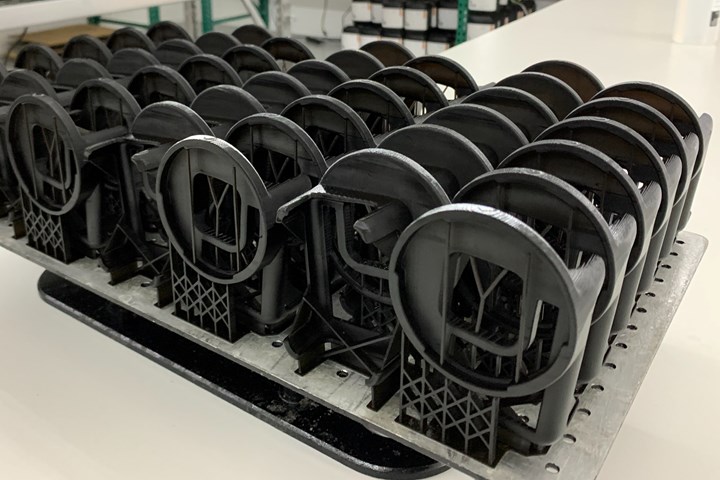
One photopolymer 3D printer is capable of producing several hundred parts per day of components about this size. These are parts for a Merit3D customer (see PhoneSkope photo below).
2. Scalability. AM can do production, but can it do mass production? At the outset of a new product’s introduction, it may be that large-quantity production is not needed, and this point represents a vital and significant advantage for AM over molding. But what if demand is large? A production process for this or any such product has to be capable of scaling up as the product succeeds and awareness and demand grow. For 3D printing, scaling up means buying more machines. The Photocentric machines Dustless has been using demonstrate how realistic this scaling up has become. Production rate on these machines (currently used for contract work — more on that below) is often 200 to 800 parts per machine per day, depending on part size. Meanwhile, the U.S. dollar cost of each machine is in the low five figures, and machine delivery has been about two weeks. These factors make it reasonable for the company to proceed on the expectation of expanding production capability by adding machines as needed.
Adding part-making capability means Dustless is now creating manufacturing jobs within its rural community. A staff of five oversees the AM capacity. Advanced manufacturing skills are not needed as a prerequisite; the company is able to train in the knowledge needed for production AM.
Notably, an expansion such as this will not entail a one-to-one expansion of staffing, another way AM is very different from other manufacturing processes. Dustless, which had been a company of 30, added a manufacturing staff of five when it invested in the AM capacity. But the steps in AM — 3D printing plus curing in the case of its own printers — run so unattended that these five employees will remain sufficient for a while, even after the number of printers considerably expands.
Box number two: Check.
3. Per-Part Unit Cost. If the machines are affordable, Loveless says, and given that the shift from molding to AM takes tooling cost to zero, what remains as the most significant factor driving the cost of the polymer part is the cost of materials. And today, the material cost remains too high for most production. This is an obstacle.
For instance, to produce a component of a wet-dry vac’s housing — a plastic part that is both large in size and made in sufficient quantity to absorb the cost of a mold — 3D printing would result in a cost per part nearly 100 times that of injection molding. This example is extreme, but the point holds for the majority of parts used in Dustless’s products today.
Dustless is just beginning its AM journey, and experimenting with various existing component types to see which might transition to AM. With lower material prices, Dustless could justify more parts being made this way. Meanwhile, the opposite is also true: More part production could justify lower material prices. Loveless explains: “I talk about it with our suppliers for additive resin. They want to work with us. It’s about volume. More manufacturers doing a lot more production with these materials will allow the resins to be produced in quantities large enough to get to much lower prices.”
For now, parts that are candidates for production AM have to be (A) small enough in size to 3D print many at once and (B) either needed in small quantities, or needed in quantities expected to start small and find their full market demand gradually. The DustBuddie fits this description.
Box number three: Dustless is waiting to check it.
Dustless launched a contract manufacturing business, Merit3D. PhoneSkope is one of the customers. This company, also based in Utah, makes cases for connecting phone cameras to telephoto optics for long-distance or microscopic imaging. Until now, because it was reliant on injection molding, PhoneSkope could only support popular phone models. Thanks to the relationship with Merit3D, it now supports more obscure phone models as well, by printing the needed cases on demand.
Through contract work, Dustless is doing what it can to increase the volume of material use while it develops greater 3D printing expertise. Or, more accurately, a sister company is doing this: Merit3D is a contract manufacturing service Loveless launched for the 3D printing capability bought by Dustless that is now helping other companies advance with AM. Merit3D is an important part of Dustless’s journey right now, because it offers a way to fill the 3D printer capacity while the company waits on the continuing advance of AM to shift more of its wet-dry-vac-related parts from molding to additive. Fortunately, there has been so much demand for Merit3D to assist companies with additive production that the company so far hasn’t needed to market its services and has been able to fill its capacity working with customers in Utah alone.
Build More Here
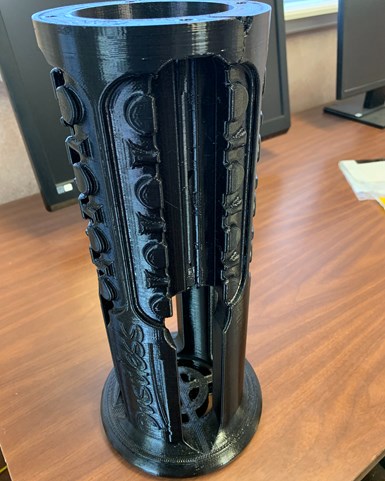
Dustless also uses a different mode of 3D printing, fused filament fabrication (FFF), for prototyping and very low-volume parts. This part, made on a Creality 3D printer, is a prototype for part of a liquid-level-driven shutoff valve for a wet-dry vac. At present, Dustless's AM capability generally is not cost-effective for parts this large. However, the current version of this valve is made from metal components and entails considerable assembly. Thanks to labor reduction via part consolidation, plus the way this version will function better through airflow improvements made possible in the AM version, this part might prove to be a candidate for production on the photopolymer production machines.
Loveless says that very demand, discovered so close, gets at the reason why he was unhappy with offshored production and intent on finding an alternative. Reshoring for him is not just about returning manufacturing to a nation, but also to a place he knows as home. Such as Utah — or Price.
Dustless’s hometown was built on coal mining, he notes, an industry and an activity facing an uncertain future at best. And while one small company such as Dustless or Merit3D cannot hope to serve the local labor force to the scale at which jobs in coal mining employ people here, still he is proud of this fact: Dustless is adding manufacturing jobs in Price, jobs focused on advanced manufacturing technology.
He says, “This is why we want to do the work here … so the income and opportunity of the manufacturing jobs go toward supporting and building up the families right here in our community.”
Related Content
3D Printed Spares, Electrification and Cool Parts: Top 10 Stories of 2022: AM Radio #31
Our top articles and videos from 2022 reflect increasing use of additive manufacturing for replacement parts; growing applications for electric motors; and a maturing user base. Read through the top 10 list or listen to the AM Radio podcast episode all about these stories.
Read MoreWhat Does AM Want? Here Are 4 Aims (Maybe 5) That Additive Manufacturing Is Driving Toward
Certain freedoms and contributing factors allow additive manufacturing to realize its full promise for production.
Read MoreAdditive Manufacturing Production at Scale Reveals the Technology's Next Challenges: AM Radio #28
Seemingly small issues in 3D printing are becoming larger problems that need solutions as manufacturers advance into ongoing production and higher quantities with AM. Stephanie Hendrixson and Peter Zelinski discuss 6 of these challenges on AM Radio.
Read MoreAt General Atomics, Do Unmanned Aerial Systems Reveal the Future of Aircraft Manufacturing?
The maker of the Predator and SkyGuardian remote aircraft can implement additive manufacturing more rapidly and widely than the makers of other types of planes. The role of 3D printing in current and future UAS components hints at how far AM can go to save cost and time in aircraft production and design.
Read MoreRead Next
Additive Manufacturing Creates New Paths to Production
On the journey from product idea to production, when does the “mold moment” come? That is, the moment of needing to invest in tooling and make design commitments. 3D printing can delay this step on the journey or even avoid it altogether.
Read MoreHow Tilt Hydrometer Fights Supply Chain Disruption with 3D Printing
The maker of a digital hydrometer for beer brewing keeps its supply chain and product flexible through selective laser sintering of a critical component.
Read More3D Printed Plastic Replaces Metal: The Cool Parts Show #3
This small business owner discovered 3D printing as a way to manufacture his invention. Now, AM is enabling a totally new source of revenue. Watch The Cool Parts Show to see how.
Read More




